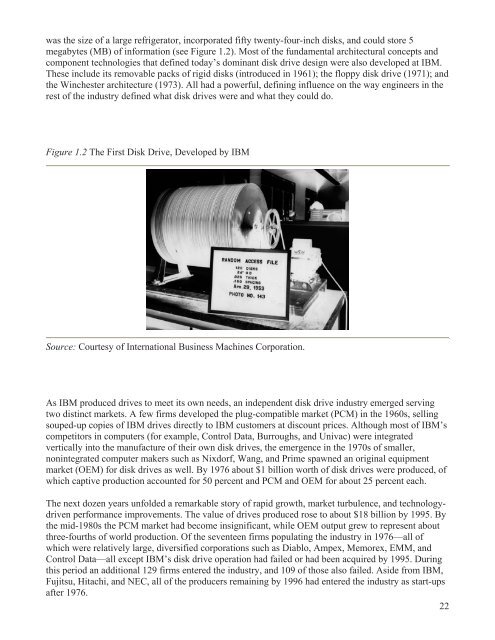PRUEBAS
PRUEBAS
PRUEBAS
Create successful ePaper yourself
Turn your PDF publications into a flip-book with our unique Google optimized e-Paper software.
was the size of a large refrigerator, incorporated fifty twenty-four-inch disks, and could store 5megabytes (MB) of information (see Figure 1.2). Most of the fundamental architectural concepts andcomponent technologies that defined today’s dominant disk drive design were also developed at IBM.These include its removable packs of rigid disks (introduced in 1961); the floppy disk drive (1971); andthe Winchester architecture (1973). All had a powerful, defining influence on the way engineers in therest of the industry defined what disk drives were and what they could do.Figure 1.2 The First Disk Drive, Developed by IBMSource: Courtesy of International Business Machines Corporation.As IBM produced drives to meet its own needs, an independent disk drive industry emerged servingtwo distinct markets. A few firms developed the plug-compatible market (PCM) in the 1960s, sellingsouped-up copies of IBM drives directly to IBM customers at discount prices. Although most of IBM’scompetitors in computers (for example, Control Data, Burroughs, and Univac) were integratedvertically into the manufacture of their own disk drives, the emergence in the 1970s of smaller,nonintegrated computer makers such as Nixdorf, Wang, and Prime spawned an original equipmentmarket (OEM) for disk drives as well. By 1976 about $1 billion worth of disk drives were produced, ofwhich captive production accounted for 50 percent and PCM and OEM for about 25 percent each.The next dozen years unfolded a remarkable story of rapid growth, market turbulence, and technologydrivenperformance improvements. The value of drives produced rose to about $18 billion by 1995. Bythe mid-1980s the PCM market had become insignificant, while OEM output grew to represent aboutthree-fourths of world production. Of the seventeen firms populating the industry in 1976—all ofwhich were relatively large, diversified corporations such as Diablo, Ampex, Memorex, EMM, andControl Data—all except IBM’s disk drive operation had failed or had been acquired by 1995. Duringthis period an additional 129 firms entered the industry, and 109 of those also failed. Aside from IBM,Fujitsu, Hitachi, and NEC, all of the producers remaining by 1996 had entered the industry as start-upsafter 1976.22


